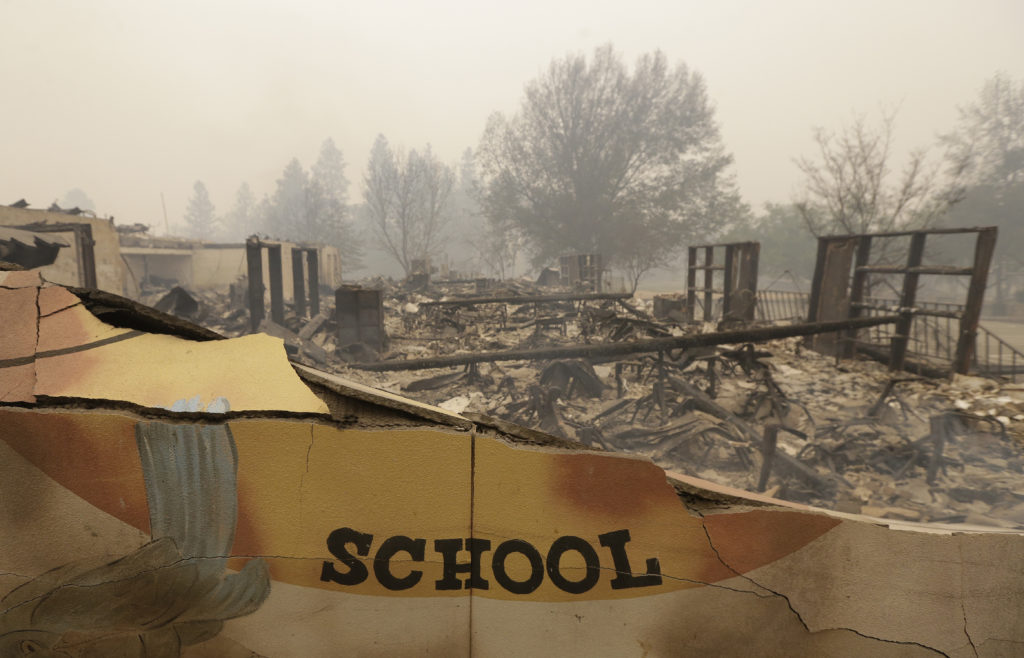
The burned remains of the Paradise Elementary school on Nov. 9, 2018, in Paradise. Blocks and blocks of homes and businesses in the Northern California town were destroyed by a wildfire.
Credit: AP/Rich Pedroncelli
Starting next March, California school districts will be required to post a plan on their websites outlining how they will provide instruction to students within 10 school days of an emergency that keeps children from attending classes. They should also make contact with students and families within five days of the emergency. Last week, Gov. Gavin Newsom signed the education trailer bill as part of the 2024-25 budget.
The plan must be operative by July 1, 2025.
Local educational agencies — school districts, charter schools and county offices of education — that do not develop an instructional continuity plan as part of their school safety plan will not be eligible to recover lost state attendance funding if schools close or a significant number of students are unable to attend because of an emergency.
In a separate action, the trailer bill also addresses chronic absenteeism by authorizing school districts to provide attendance recovery programs during school breaks, weekends or after school, to allow students to make up for up to 10 days of school missed for any reason. Beginning next July, districts that offer the programs will be able to recover state funds lost when students in the program were previously absent from school.
The legislation comes four years after California schools closed for more than a year because of a worldwide pandemic. Since then, chronic absenteeism rates have more than doubled. Wildfires and flooding also have closed schools across the state with increasing frequency in recent years.
“Given the effects of public health emergencies and the significant and growing number of natural disasters that the state has faced in recent years, there is an increased need for local educational agencies to provide instructional continuity for pupils when conditions make in-person instruction infeasible for all or some pupils,” according to the trailer bill.
The instructional continuity plan must describe how districts will provide in-person or remote instruction to students, including potentially temporarily reassigning them to other school districts. Students who are reassigned during an emergency will not have to comply with any residency requirements for attendance in that district.
Penalties removed
The legislation has changed dramatically since the May budget revision, which would have given districts five days to offer students instruction after an emergency, and penalized them financially if they didn’t.
The revisions are due, in part, to heavy opposition from a coalition of nine education organizations, including the California Teachers Association, California School Boards Association and California County Superintendents.
“There are countless instances where the physical infrastructure and human capacity necessary to comply with this requirement does not exist: roads, landlines, internet connectivity, access to devices, access to shelter, family and staff displacement, etc.,” said California County Superintendents in a May letter to the chairs of the Senate and Assembly budget committees. “When this occurs, a LEA may find it impossible to offer remote instruction.”
Derick Lennox, senior director for governmental relations and legal affairs for the association said, “There was the feeling that the state does not understand the challenges that schools face to locate and serve the basic needs of their students and families during a serious emergency.”
As an alternative, the coalition asked for a proactive planning process without financial penalties, and lawmakers agreed, Lennox said.
El Dorado County Superintendent of Schools Ed Manansala said that the proactive, constructive tone of the new legislation is more productive than the punitive tack legislators took in the original version.
Manansala said it isn’t feasible to expect schools to deliver instruction 10 days after schools close in an emergency.
El Dorado County has had at least 70 wildfires of varying sizes between 2004 and 2023, the largest being in August 2021, according to CalFire. It burned 221,835 acres and razed Walt Tyler Elementary School in Grizzly Flats.
“We had teachers and students that were being displaced out of their communities,” Manansala said.
Mendocino County Superintendent of Schools Nicole Glentzer first experienced the extended closure of schools in 2017 when a fire burned 36,000 acres.
Glentzer, who worked at nearby Ukiah Unified School District at the time, had to evacuate her home. She moved into the district office and went to work making decisions about school closures. The district’s schools were closed for five days.
Since then, the county on the state’s north coast has been ravaged by numerous fires, including two of the nation’s largest, which together burned more than 1.41 million acres in multiple counties in 2018 and 2020.
Schools in Mendocino County also have been closed recently because of flooding and power outages.
Glentzer said that while she is satisfied with the revamped language in the legislation, she cringes when she hears that small districts, with small staffs, are expected to come up with plans similar to larger districts. The Mendocino County Office of Education will help the 12 school districts in its county by providing sample plans and templates, she said.
Attendance recovery
State chronic absentee numbers have skyrocketed from 12.1% in 2018-19 to 30% in 2021-22, according to an analysis of California data. Chronic absenteeism rates are determined by the number of students who miss at least 10% of school days in a given year.
Attendance recovery programs like the one required by the new legislation can help districts reduce their chronic absenteeism and regain the average daily attendance funding lost when students miss school. The programs must be taught by credentialed teachers and be aligned to grade-level standards and to each student’s regular instructional program, according to the legislation.
Attendance recovery programs can be funded through the Expanded Learning Opportunities Program at school sites where the after-school or summer enrichment programs are being offered and operated by the school district.
“In my mind, it’s a whole theme that the administration and Legislature are going for, around addressing chronic absenteeism — one of the top issues facing students today,” Lennox said. “And, they basically outlined a few different strategies to do it.”


